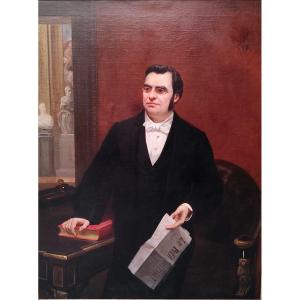At first, from a distance, the portrait seems like a standard formulaic head and shoulders one, but upon closer inspection, there are elements that are very alive, and have been rendered in a painterly style. The texture and highlights of the white chemise are particularly pleasing and have been rendered with urgency, using a palette knife to cut in horizontal strokes into the impasto. It is remarkable that these details are so well preserved after circa 300 years – which is, sadly, most often not the case in the majority of works of this age, often due to poor restoration.
This portrait typifies Dahl’s eloquent depiction of aristocratic women. His portraits are often softer than the work of his rival, Godfrey Kneller, and they often achieve a certain elegance without the use of flashy props and other distractions in the composition. This example is a simple yet elegant portrait with a clear fresh palette, bright eyes, and beautiful rendering.
Presented in a good carved and gilded antique frame.
Michael Dahl trained in Sweden but at the age of 23 came to England in search of patronage, after political turmoil in Stockholm reduced the wealth and power of the aristocracy. A number of Dahl’s compatriots saw England as being relatively stable and prosperous compared to many European countries, and more welcoming than France, for example, of the Lutheran faith then prevalent in Sweden. Between 1682 and 1683, according to Vertue, he was an associate or pupil or Sir Godfrey Kneller. In 1685 he left England for France and Italy, studying in Rome for two years. There he converted to Roman Catholicism and gravitated towards the circle of the exiled Queen Christina of Sweden, who while resident in Rome, had also converted. In 1685 Dahl secured a commission to paint a portrait of Queen Christina (Grimsthorpe Castle, Duke of Ancaster Collection) which secured him instant success not only in the Rome but also in England on his return there in 1688-89. Perhaps he hoped to receive the support of the Catholic King James II but by the time he arrived the ‘Glorious Revolution’ had deposed James and replaced him with his daughter Mary and her Protestant husband William of Orange. Dahl did not portray the new monarchs, but did gain much patronage from the rest of the court, and in particular Prince George of Denmark, the husband of the future Queen Anne – but many of his new clients in London were Swedish emigres and diplomats and he rapidly became a member of this closely-knit Swedish circle. Dahl’s portraits can today be found in numerous collections and country houses.
Provenance:
UK private collection
Measurements:
Height 84.5cm, Width 72cm framed (Height 33.25”, Width 28.25” framed)


























 Le Magazine de PROANTIC
Le Magazine de PROANTIC TRÉSORS Magazine
TRÉSORS Magazine Rivista Artiquariato
Rivista Artiquariato
